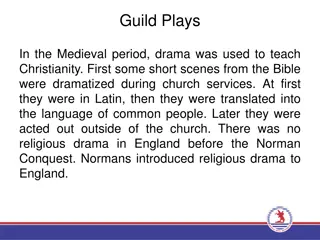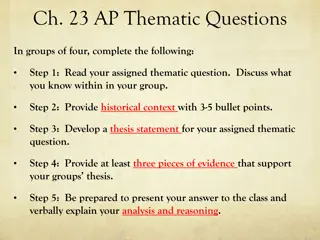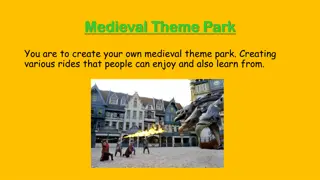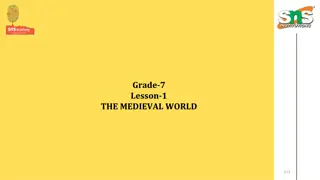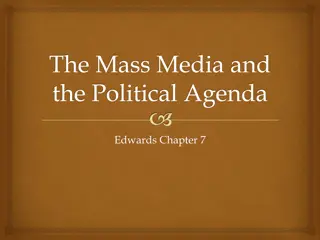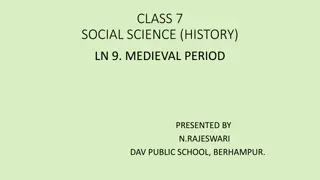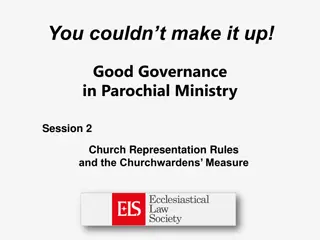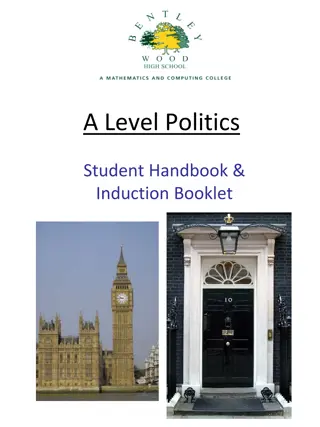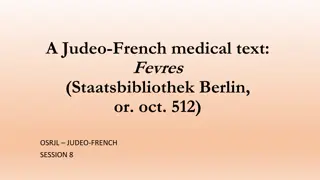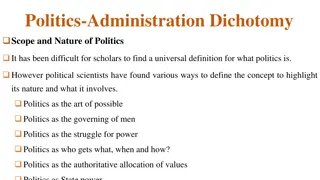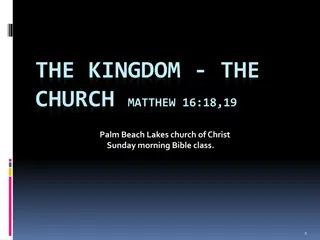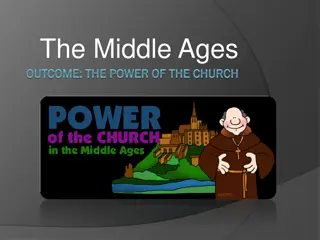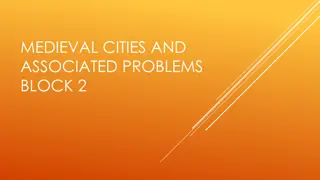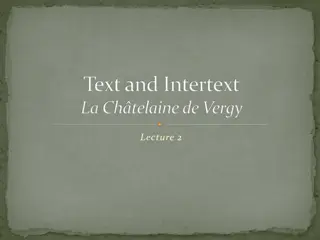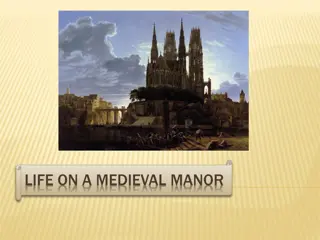The Church and Politics in Medieval Europe - Lecture Summary
Dr. Ann T. Orlando's lecture covers the intertwined relationship between the Church and politics in medieval Europe, discussing key events such as the Holy Roman Empire, Charlemagne's reign, and the Peace (Truce) of God Movement. Focus areas include social, economic developments, and the Church's role in governance and society.
Download Presentation

Please find below an Image/Link to download the presentation.
The content on the website is provided AS IS for your information and personal use only. It may not be sold, licensed, or shared on other websites without obtaining consent from the author. Download presentation by click this link. If you encounter any issues during the download, it is possible that the publisher has removed the file from their server.
E N D
Presentation Transcript
Lecture 14 The Church and Politics in Medieval Europe Dr. Ann T. Orlando 18 October 2018 1
Introduction Review 10th-11th C Europe Holy Roman Empire Church Scandal Simony Married clergy Papal elections Lay Investiture Medieval Monasticism 2
Review History 600 - 900 Muslim Arab armies conquer much of Eastern Empire, Southern Mediterranean, North Africa, Spain Expansion into Europe stopped by Charles Martel (Charlemagne s grandfather) and Pepin the Short (Charlemagne's father) Charlemagne United Western Europe Crowned by Pope Leo III in 800 After Charlemagne Kingdom divided between his sons Infighting among them led to fracturing of political unity in Europe Papal claims to political control in West Eastern Roman Empire (Byzantine Empire) Lost its southern Mediterranean territory to Arab armies Increasingly unhappy with Western claims to be the Roman Empire 3
Social and Economic Developments around 10th C Population begins to rise, perhaps due to climate change; between 500 and 1000 AD: Perhaps an increase of 30% in Western Europe Increase of 75% in Eastern Europe New settlements develop for increased population around newly developed farm land Large land owners (feudal lords) control local economy and peoples (serfs) Church develops a new system for ministry to new settlements: the parishes (parochiae) To be a parish, the settlement needed a parish church Priest from the local diocese was expected to live in the parish Needed support of the people to maintain himself (benefice) and offer charity to needy parish members 4
Peace (Truce) of God Movement Began in France in Le Puy (Aquitaine) in 975 Grassroots movement beginning in 10th C by priests and local bishops to protect people, especially the needy, and Church officials and property from violence Needed because of the social disruption caused by dissolution of Carolingian dynasty Rise of disorder and violence associated with the Vikings (Normans) Peace of God local councils held throughout the 10 to 12 C 5
Developments in Holy Roman Empire (Germany, Austria, Northern Italy) Otto I, the Great, (912-973) established a strong kingdom in the center of Europe on the Carolingian model Conquered northern Italy 951 Defeated Magyar invasions 955 Crowned Holy Roman Emperor by Pope John XII Beginning of a concept last until 1806 (or maybe 1918) Henry III (ruled 1039-1056) powerful enough to control papacy But his son, Henry IV was not 6
Pope and Holy Roman Emperor Otto the Great, King of East Franks (Germans), King/Emperor ruled 936- 973 Made bishops civil officials within his kingdom Emperor gives the bishop the civil and religious symbols of his office Beginning of lay investiture controversy Celibacy of bishops meant Otto did not have to worry about competing families to his own http://www.metmuseum.org/toah/images/h2/ h2_17.190.229.jpg 7
10th C Papacy Century after Charlemagne and his successors Political power in Europe shifted to Germany (Holy Roman Empire, Otto I) Papal military and political alliances shaky Popes of 10th C infamous for corruption and scandal Cadaver Synod of 897; Pope Stephen VI tried the corpus of his predecessor, Pope Formosus Stephen VI subsequently strangled by his enemies John XII (d. 964) supposedly died while making love to a prostitute Benedict VI (d. 974) smothered by his political enemies Papacy the instrument of competing aristocratic Roman families Nepotism Simony Widespread sexual, fiscal abuse by clergy at all levels Reform will come from monastery 9
Otto and Pope John XII (Part 1) Pope John XII reigned 955-964 From wealthy Tuscan family Led troops into battle in northern Italy John established an alliance with Otto, who agreed to send troops to help John John XII crowned Otto Holy Roman Emperor In return agreement that no Pope could be elected without consent of Holy Roman Emperor 10
Otto and Pope John XII (Part 2) Otto concerned about John s personal morality, and seems to have lectured him about this John concerned that Otto was becoming too powerful in Italy John sends envoys to Magyars in Hungary and Byzantines suggesting an alliance against Otto Otto discovers this and deposes John XII, establishes Leo VIII as anti-pope Leo was a layman when elected pope Leo gave Otto the right to appoint bishops The later portion of Leo s pontificate is considered legitimate 11
Pope St. Leo IX (r. 1049-1054) French Benedictine Tried to remove papacy from Roman family politics Appointment of reforming cardinal bishops such as Peter Damian Revised canon law in the Collection in 74 Titles which emphasized role of Pope as head of court of appeals Tried to take strong action against married clergy leading to clerical riots Tried to take strong action against simoniac bishops ordaining for money Re-ordination controversy Used Donation of Constantine against Patriarch Michael Cerularius in 1054 Strongly allied with HRE Henry III Died after unsuccessful military campaign against Normans in Southern Italy 12
Pope Nicholas II (r. 1059-1061) Most significantly changed the way pontiffs were elected By cardinal bishops Approved by other cardinals Approved by people of Rome Attempt to exclude Roman family politics and HRE from exercising control over papal elections Henry IV (son of Henry III) was only 6 at the time Nicholas II also signed a peace treaty with the Normans, affirming kingship of Robert Guiscard in Sicily and southern Italy (over objections of the Germans) In return, Normans promised to provide military support for any pope elected via the new procedure 13
Pope St. Gregory VII (1020-1085) Entered Cluny as a young man Known as a reformer in the mold of Peter Damian Elected Pope amid great dissention 1073 Key ecclesial changes in his pontificate Deposition of all clergy who achieved office through simony Forbade married priests to celebrate Mass Most famous for encounter with Emperor Henry IV and lay investiture of bishops Set stage for his successor Urban II Crusades Establishment of Curia and more efficient papal administration 14
Pope and HRE (cont.) Pope Gregory VII assertion of Papal primacy, Dictatus Papae; Emperor cannot invest bishops with symbols of office, or participate in election of Pope Henry IV refuses to accept Dictatus Papae Pope Gregory VII excommunicated Emperor Henry IV; Henry repents at Canossa and is forgiven But in 1081 Henry seeks revenge on Gregory, who is forced to flee Rome Gregory dies in exile 15
Pope and HRE (cont.) Concordat of Worms (1122) Compromise resolves (temporarily) issues between Pope and Holy Roman Emperor Agreement between Pope Calixtus II and Henry V Pope selects bishops and abbots, and invests them with symbols of spiritual office Emperor can invest bishops and abbots with lay responsibilities and be present at installation 16
Vital Social Role of Monasteries Agricultural advances Economic developments Medicinal (hospitals) Education Support for pilgrims Democratic advancement 17
Benedictine Organization Once a monastery became too large, another was established Daughter monastery only loosely associated with mother house All monasteries follow the Rule, but Rule leaves many decisions under local control of individual abbot and communities 18
Problems with Benedictine Structure Somewhat like bishops, monasteries become important objects of local control Since there is no oversight through a hierarchy of monasteries, some Benedictine monasteries become endowed and controlled by local wealthy families, Especially true in France, from the time of Charlemagne 19
Monasticism: Cluny Charter for Foundation of Cluny, 910 Return to Benedict s Rule; especially reading of Divine Office But encouraged prayer and study over physical work Established a series of daughter monasteries under the direction of the abbot of Cluny While monks were poor, monasteries became wealthy Encouraged development of visual arts in service of religion Abbot Suger: Man rises to God through beauty 20
Romanesque Art: 10, 11th C Impact of Cluny Example: Vezelay (where Bernard preached 2nd Crusade) http://www.bc.edu/bc_org/avp/cas/fnart/a rch/vezelay.html vezelay01t vezelay09t vezelay13t 21
St. Peter Damian (1007-1072) Entered a Cluniac Monastery near Gubbio, Italy Deeply concerned about sexual license among clergy and corruption of papacy Preached against simony Through tireless preaching and teaching brought about some reforms Close friends of Hildebrand (soon to be Pope Gregory VII) Doctor of Church 22
Monasticism: Anchorites Peter Damian suggested that a more hermetic life might be appropriate to get back to the desert and spirituality Peter Damian was a Camaldolese monk Camaldolese founded in 1027 by St. Romauld to encourage more hermetic observance of the Benedictine Rule 23
Carthusians Several new orders founded to encourage a more hermetic life, most famous Carthusians Founded by St. Bruno (1030-1101) in 1084 Named for motherhouse in Chartreuse Each monk lives alone in silence following a new Rule written by St. Bruno Never reformed because never deformed. 24
Monasticism: Citeaux Reform of Cluny: Cistercians Founded by St. Robert Molesme at Citeaux 1099 Return to strict adherence to Benedict s Rule; work equal with prayer and study Each monastery independent; that is, each had its own abbot More severe artistic style Bernard of Clairvaux most famous Cistercian (1090-1153) Modern day Trappists; Spencer, MA. SJS 25
Bernard of Clairvaux (1090-1153) Established Cistercian monastery at Clairvaux Opposed Peter Abelard (1078-1142): I must understand in order that I might believe Opposed Cluny-type monasticism as being too interested in worldly beauty and pleasure Preached the Second Crusade (1144) Wrote very length commentary on Song of Songs in which he refers to both Gregory of Nyssa and Origen; highly allegorical Special devotion to Mary Encouraged mysticism that moved away from physical; apophatic SJS 26
St. Bernards Devotion to Mary Mary subject of many homilies Author of famous Marian prayer REMEMBER, O most gracious Virgin Mary, that never was it known that anyone who fled to thy protection, implored thy help, or sought thy intercession was left unaided. Inspired with this confidence, I fly to thee, O Virgin of virgins, my Mother; to thee do I come; before thee I stand, sinful and sorrowful. O Mother of the Word Incarnate, despise not my petitions, but in thy mercy hear and answer me. Amen.
Orders of Canons Regular Considered a quid medium between monks and secular clergy First developed during Charlemagne s rule as part of clerical reform Like monks Lived in community Prayed Divine Office together Unlike monks Ordination to priesthood expected Responsible for teaching and preaching, Often under direct authority of local bishop Because of duties, followed Augustine's Rule 28
Canons Regular of Premontre (Norbitines) Established by St. Norbert (1080-1134) in 1120 An effort to create dedicated priests removed from temptations of secular world. St. Norbert was a friend of St. Bernard, who encouraged him to found the Norbitines Norbitines follow Augustine's Rule 29
Assignments Charter of Cluny, http://www.fordham.edu/halsall/source /chart-cluny.html Pope Gregory VII, Dictatus Papae, http://www.fordham.edu/halsall/source /g7-dictpap.asp Bernard, Apology, http://sourcebooks.fordham.edu/source /bernard1.asp 30
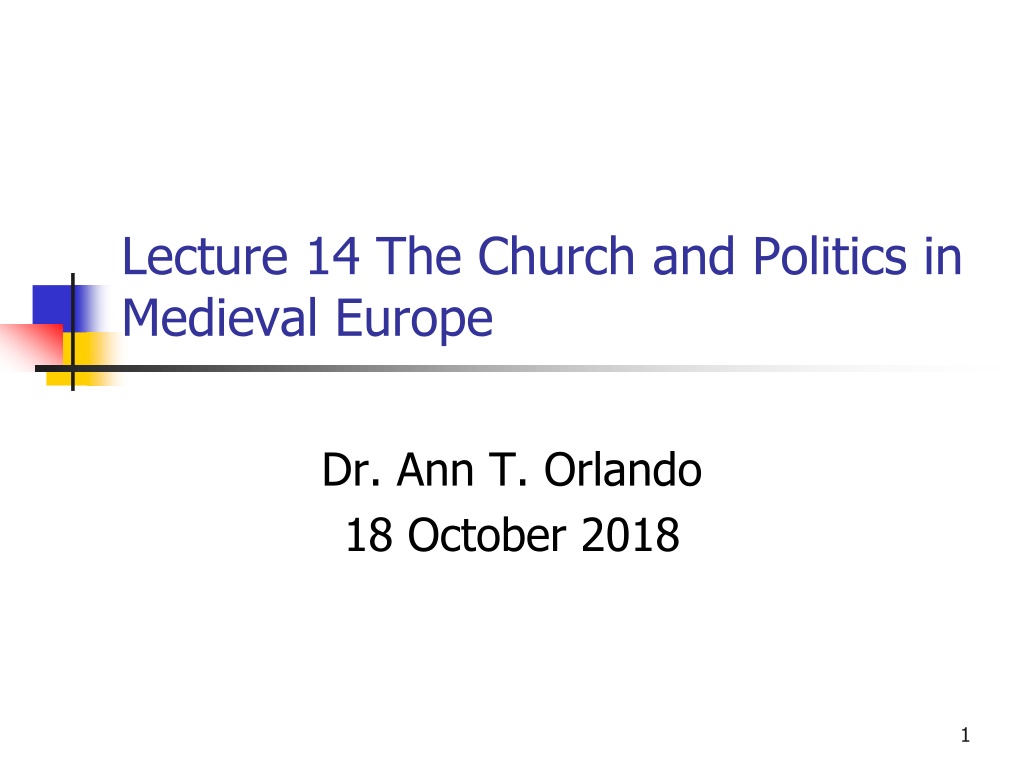
 undefined
undefined










